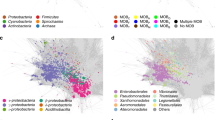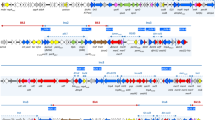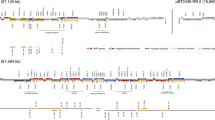Abstract
IN Pseudomonas bacteria, the plasmids of the P-2 incompatibility group (IncP2) are notable for several reasons: they include both antibiotic resistance plasmids of nosocomial origin (R plasmids) and degradative plasmids that allow dissimilatory oxidative metabolism of unusual carbon sources; they are a naturally occurring high frequency transfer system with a host range restricted primarily to Pseudomonas; they are reported to be the most frequent incompatibility group of R plasmids found in nosocomial Pseudomonas aeruginosa isolates; and they show a wide geographical distribution1–4. Until now, their classification as plasmids has primarily been on the basis of genetic evidence: cotransfer of plasmid phenotypic markers independent of chromosome transfer; and co-curing of plasmid markers by another IncP2 plasmid. We have developed a novel method to permit routine physical isolation of these plasmids5. Using this method, a survey of the sizes of 12 different IncP2 plasmids reveals them to be notable in another way: they constitute an unique group of very large bacterial plasmids, generally having a homogeneous, unprecedented size range between approximately 280 and 312 megadaltons.
This is a preview of subscription content, access via your institution
Access options
Subscribe to this journal
Receive 51 print issues and online access
$199.00 per year
only $3.90 per issue
Buy this article
- Purchase on Springer Link
- Instant access to full article PDF
Prices may be subject to local taxes which are calculated during checkout
Similar content being viewed by others
References
Bryan, L. E., Semaka, S. D., Van Den Elzen, H. M., Kinnear, J. E. & Whitehouse, R. L. S. Antimicrob. Ag. Chemother. 3, 625–637 (1973).
Jacoby, G. A. in Microbiology 1977 (ed. Schlessinger, D.) 119–126 (American Society for Microbiology, Washington, DC, 1977).
Sagai, H. et al. Antimicrob. Ag. Chemother. 10, 573–578 (1976).
Shahrabadi, M. S., Bryan, L. E. & Van Den Elzen, H. M. Can. J. Microbiol. 21, 592–605 (1975).
Hansen, J. B. & Olsen, R. H. J. Bact. 135, 227–238 (1978).
Kline, B. C. et al. J. Bact. 127, 881–889 (1976).
Meyers, J. A., Sanchez, D., Elwell, L. P. & Falkow, S. J. Bact. 127, 1529–1537 (1976); and Errata J. Bact. 129, 1171 (1977).
Chakrabarty, A. M. A. Rev. Genet. 10, 7–30 (1976).
Palchaudhuri, S. Biochem. biophys. Res. Commun. 77, 518–525 (1977).
Fennewald, M., Prevatt, W., Meyer, R. & Shapiro, J. Plasmid 1, 164–173 (1978).
Pemberton, J. M. J. Bact. 119, 748–752 (1974).
Jacoby, G. A. & Shapiro, J. A. Appendix B, Table 1c in DNA Insertion Elements, Plasmids, and Episomes (eds Bukhari, A. I., Shapiro, J. A. & Adhya, S. L.) 639–656 (Cold Spring Harbor Laboratory, New York, 1977).
Summers, A. O. & Jacoby, G. A. Antimicrob. Ag. Chemother. 13, 637–640 (1978).
Summers, A. O. & Jacoby, G. A. J. Bact. 129, 276–281 (1977).
Manis, J. J. & Whitfield, H. J. J. Bact. 129, 1601–1606 (1977).
Jacob, A. E. et al. Appendix B, Table 1b, in DNA Insertion Elements, Plasmids, and Episomes (eds Bukhari, A. I., Shapiro, J. A. & Adhya, S. L.) 607–638 (Cold Spring Harbor Laboratory, New York, 1977).
Author information
Authors and Affiliations
Rights and permissions
About this article
Cite this article
HANSEN, J., OLSEN, R. IncP2 group of Pseudomonas, a class of uniquely large plasmids. Nature 274, 715–717 (1978). https://doi.org/10.1038/274715a0
Received:
Accepted:
Issue Date:
DOI: https://doi.org/10.1038/274715a0
This article is cited by
-
Genetics of alkane oxidation byPseudomonas oleovorans
Biodegradation (1994)
-
TherecA-dependent spontaneous degradation of proximal F merogenotes inEscherichia coli
Folia Microbiologica (1982)
-
The relationship of degradative and resistance plasmids of Pseudomonas belonging to the same incompatibility group
Nature (1979)
Comments
By submitting a comment you agree to abide by our Terms and Community Guidelines. If you find something abusive or that does not comply with our terms or guidelines please flag it as inappropriate.



